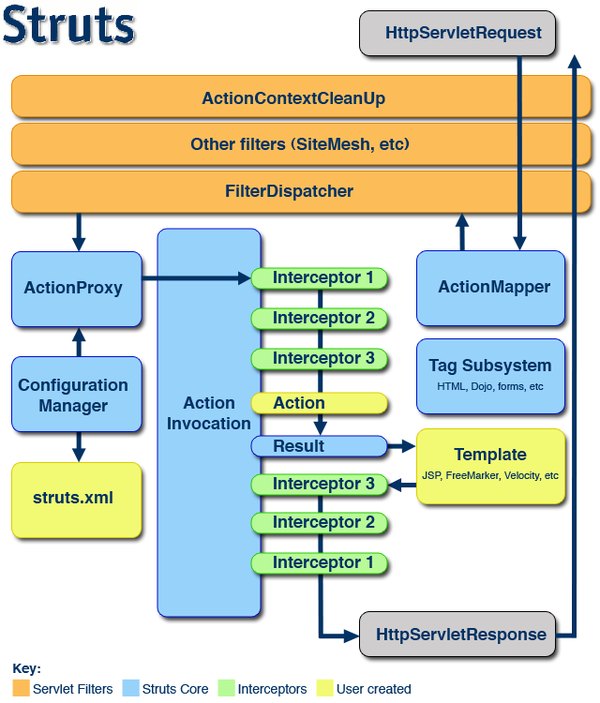1.1 例子
第一步:把struts2最低配置的jar包加入的项目中。
commons-logging-1.0.4.jar
freemarker-2.3.8.jar
ognl-2.6.11.jar
struts2-core-2.0.11.jar
xwork-2.0.4.jar
第二步:在web.xml中加入拦截器配置。
<filter>
<filter-name>struts2</filter-name>
<filter-class>org.apache.struts2.dispatcher.FilterDispatcher</filter-class>
</filter>
<filter-mapping>
<filter-name>struts2</filter-name>
<url-pattern>/*</url-pattern>
</filter-mapping>
第三步:把空的struts.xml配置文件放到项目src下面。
<struts>
</struts>
第四部:编写自定义的action类。
package test;
import com.opensymphony.xwork2.ActionSupport;
public class HelloAction extends ActionSupport {
private String str;
public String hello() {
this.str = "hello!!!";
return "success";
}
public String getStr() {
return str;
}
public void setStr(String str) {
this.str = str;
}
}
第五步:编写struts.xml配置文件。
<struts>
<package name="test" namespace="/np" extends="struts-default">
<action name="hello" class="test.HelloAction" method="hello">
<result name="success">/hello.jsp</result>
</action>
</package>
</struts>
第六步:编写hello.jsp文件。
<%@ page language="java" contentType="text/html; charset=UTF-8" pageEncoding="UTF-8"%>
<%@ taglib prefix="s" uri="/struts-tags"%>
<!DOCTYPE html PUBLIC "-//W3C//DTD HTML 4.01 Transitional//EN""http://www.w3.org/TR/html4/loose.dtd">
<html>
<head>
<meta http-equiv="Content-Type" content="text/html; charset=UTF-8">
<title>Test</title>
</head>
<body>
<h1><s:property value="str"/></h1>
</body>
</html>
第七步:启动tomcat,在浏览器中访问:
http://localhost:8080/hello/np/hello.action
hello 是项目名字
np 命名空间,对应namespace里面的字符串。
hello.action 其中hello对应action里面的字符串,“.action”表示请求的是一个action。
1.2 运行机制
1)客户端在浏览器中输入一个url地址。
2)这个url请求通过http协议发送给tomcat。
3)tomcat根据url找到对应项目里面的web.xml文件。
4)在web.xml里面会发现有struts2的配置。
5)然后会找到struts2对应的struts.xml配置文件。
6)根据url解析struts.xml配置文件就会找到对应的class。
7)调用完class返回一个字String,根据struts.xml返回到对应的jsp。
1.3 struts2流程

上图来源于Struts2官方站点,是Struts 2 的整体结构。
一个请求在Struts2框架中的处理大概分为以下几个步骤:
1) 客户端初始化一个指向Servlet容器(例如Tomcat)的请求。
2) 这个请求经过一系列的过滤器(Filter)。
3) 接着FilterDispatcher被调用,FilterDispatcher询问ActionMapper来决定这个请是否需要调用某个Action。
4) 如果ActionMapper决定需要调用某个Action,FilterDispatcher把请求的处理交给ActionProxy。
5) ActionProxy通过Configuration Manager询问框架的配置文件,找到需要调用的Action类。
6) ActionProxy创建一个ActionInvocation的实例。
7) ActionInvocation实例使用命名模式来调用,在调用Action的过程前后,涉及到相关拦截器(Intercepter)的调用。
8) 一旦Action执行完毕,ActionInvocation负责根据struts.xml中的配置找到对应的返回结果。
Struts2的核心就是拦截器。Struts.xml中所有的package都要extends="struts-default"。同理与所有的Java类都要extends自Object一样。struts-default.xml里面就是要做以上事情。






















 129
129

 被折叠的 条评论
为什么被折叠?
被折叠的 条评论
为什么被折叠?








